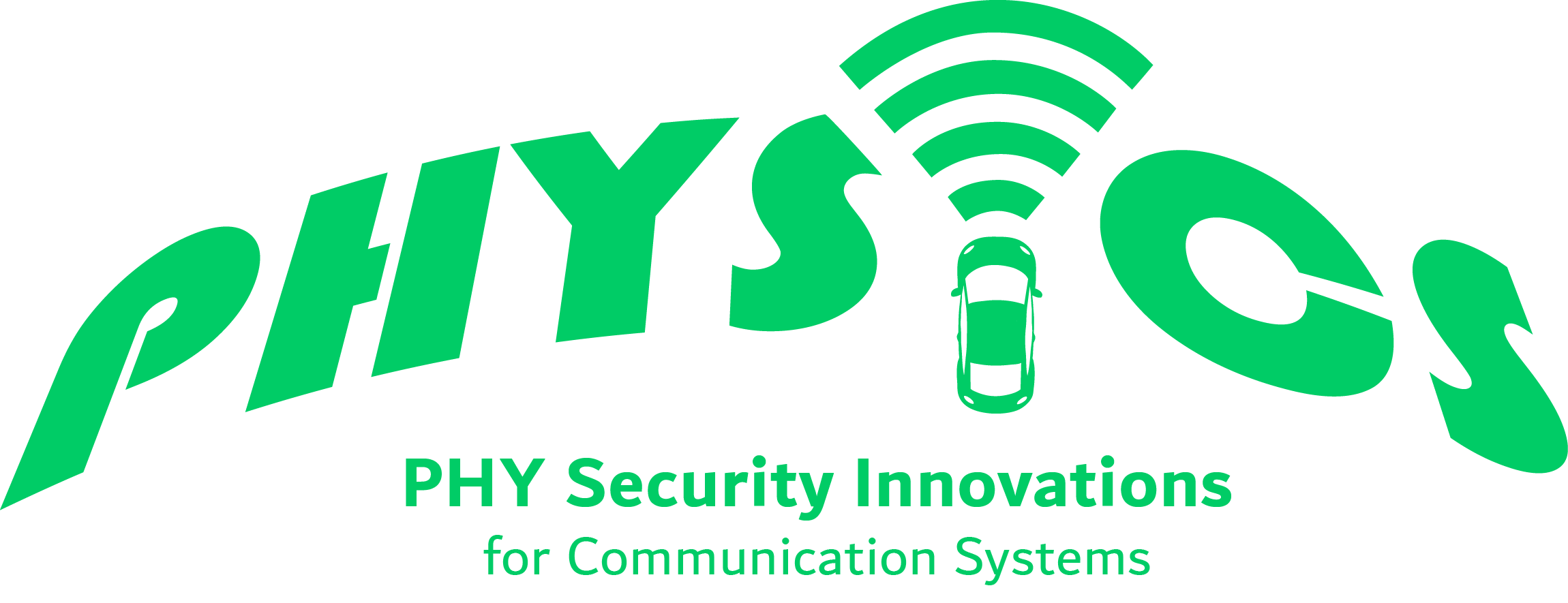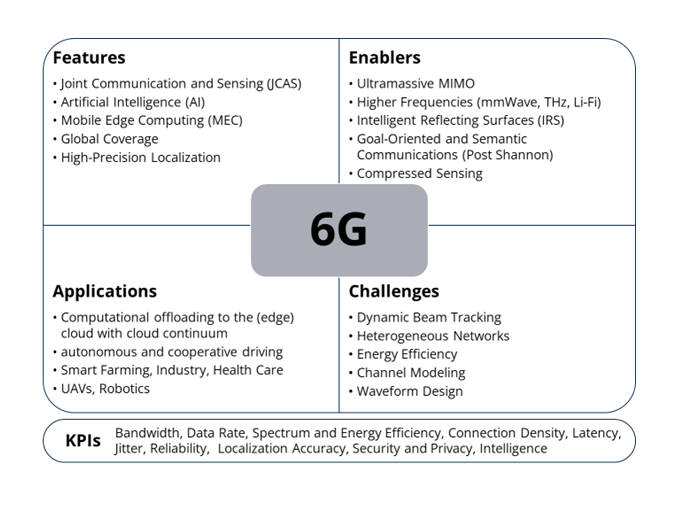– vision, enablers, key technologies and applications
6G is the upcoming sixth-generation wireless communication network, expected to launch around 2030, designed to meet the key performance requirements (KPIs) for emerging services and applications. Currently, in academia, different scenarios, enablers, key technologies, and challenges for 6G are being discussed. Figure 1 provides an overview of the main pillars and topics of the ongoing scientific discussions for 6G.
Numerous new technologies are being developed to enable the upcoming features of 6G. One feature is the integration of radar functionalities into wireless communication systems using a common waveform and hardware design in the form of Joint Communication and Sensing (JCAS). Radio Sensing is a completely novel feature to wireless systems, in addition to communication and localization capabilities. The trend towards Artificial Intelligence (AI) continues to drive advancements in wireless communication across nearly every communication layer, mobile edge computing (MEC) allows computational offloading and Non-Terrestrial Networks (NTN) allows global coverage of 6G.
One technology that enables these KPIs is space and frequency domain enhancement to enable higher bandwidths and data rates. Antennas with massive arrays enhance spatial resolution and throughput by setting up dedicated beams towards individual users or groups. The use of higher frequencies, ranging from millimeter wave (mmWave, 30 GHz to 300 GHz) to Terahertz (THz, 300 GHz to 3 THz) and even optical wireless communication (Li-Fi), further expands the possibilities. To accommodate more users and enhance communication rates, intelligent reflective surfaces (IRSs) represent another promising technology for 6G. IRS allows real-time intelligent adaptation of the wireless propagation environment through the use of reconfigurable passive elements, enabling, for example, reflections into shadowed areas for coverage improvements.
The trend towards AI, particularly deep learning (DL), presents an entirely new approach to communication. Shannon’s information theory highlights three main problems for communications: the technical problem, the semantic problem, and the effectiveness problem. In the past, research has primarily focused on the technical problem of communication, concerning how symbols are transmitted. With AI, it is now possible to enable semantic communications by encoding and decoding the semantics of information using deep neural networks (DNNs). Consequently, the required data rate and capacity on the physical channel could be significantly decreased. For example, instead of transmitting the pixel color value of every pixel in an image, semantic communication transmits only the semantics of the image described in the form of text or tags. This information is then decoded at the receiver to obtain the original image. Compressed sensing also plays a role in this context, as it is a signal processing technique that efficiently acquires and reconstructs signals by exploiting signal sparsity, allowing recovery from far fewer samples than required by the Nyquist–Shannon sampling theorem.
There are also several challenges arising from these new features and technologies, including accurate dynamic beam tracking with user motion, the trend towards heterogeneous devices, such as smartphones, IoT devices, wearables, sensors, AR/VR, etc., and the need for improved energy efficiency. Crucially, for radio sensing and communication improvements, channel modeling with deterministic ray tracing approaches is essential due to the spatial consistency of such models.
6G opens up exciting possibilities for various verticals, including transportation, health, industry, farming, robotics, and Unmanned aerial vehicles (UAVs), among others. For example, autonomous and cooperative driving could benefit from computational offloading of object detection to the edge cloud, allowing sharing of results between vehicles to enhance their field of view. However, to transfer such vast amounts of camera, radar, and LIDAR data, new concepts are required to meet the KPIs for such use cases. The solution could include semantic communication and goal-oriented communication, as well as higher frequencies for local coverage and improved communication performance. Additionally, automotive radar functionalities could be integrated into 6G with JCAS, making dedicated radar sensors obsolete.
- https://www.rfwireless-world.com/Terminology/5G-KPIs-vs-6G-KPIs.html
- M. Noor-A-Rahim u. a., „6G for Vehicle-to-Everything (V2X) Communications: Enabling Technologies, Challenges, and Opportunities“, arXiv:2012.07753 [cs, math], Dez. 2020, Zugegriffen: 24. November 2021. [Online]. Verfügbar unter: http://arxiv.org/abs/2012.07753
- Z. Zhang u. a., „6G Wireless Networks: Vision, Requirements, Architecture, and Key Technologies“, IEEE Vehicular Technology Magazine, Bd. 14, Nr. 3, S. 28–41, Sep. 2019, doi: 10/gf6r62.
- P. Yang, Y. Xiao, M. Xiao, und S. Li, „6G Wireless Communications: Vision and Potential Techniques“, IEEE Network, Bd. 33, Nr. 4, S. 70–75, Juli 2019, doi: 10/ggjdtp.
- D. Pérez-Adán, Ó. Fresnedo, J. P. González-Coma, und L. Castedo, „Intelligent Reflective Surfaces for Wireless Networks: An Overview of Applications, Approached Issues, and Open Problems“, Electronics, Bd. 10, Nr. 19, Art. Nr. 19, Jan. 2021, doi: 10.3390/electronics10192345.
- Q. Lan u. a., „What is Semantic Communication? A View on Conveying Meaning in the Era of Machine Intelligence“, arXiv:2110.00196 [cs, eess, math], Sep. 2021, Zugegriffen: 8. April 2022. [Online]. Verfügbar unter: http://arxiv.org/abs/2110.00196




